Guide
Hyperspectral imaging sensors are an effective tool for studying crops and vegetation in different environments in recent years. Plant physiology, morphology or biochemical information can be assessed in a non-contact manner and at different scales. For example, hyperspectral sensors are used for plant phenotypic analysis or physiological stress studies in precision agriculture. Up to now, there are a variety of non-imaging and imaging hyperspectral sensors available on the market, and the process of measuring these instruments is quite complicated. Therefore, there is an increasing demand for high-spectrum sensors that are easy to operate by users in modern inspection and research. Finland's new small handheld smart hyperspectral camera, SPECIM IQ, is based on the user's modern portable operation. SPECIM IQ's compact and lightweight body is only 1.3kg for easy handheld operation. At the same time, the operation control system is directly integrated into the camera, and the basic data acquisition and analysis process (such as pre-processing and real-time) can be realized in real time through the touch screen of the camera. Classification routines) for intelligent operation. Portable handheld, on-site real-time rapid detection, fully automated intelligent analysis, high-quality data, I believe that SPECIM IQ's many modern features will make your hyperspectral research more convenient!
In the following, we qualitatively compare the hyperspectral data collected by SPECIM IQ with the already mature hyperspectral imager technology SPECIM V10E. It is found that the design of SPECIM IQ portable handheld does not affect the accuracy of the camera data, and consistently obtain high quality hyperspectral. data. At the same time, the hand-held intelligent SPECIM IQ can also realize the identification of plant phenotypes and disease research and detection, and has unlimited possibilities in plant science research and other fields.
1. Qualitative comparison of handheld intelligent hyperspectral camera SPECIM IQ and SPECIM V10E
We compared the performance of the new SPECIM IQ with the superior performance of the SPECIM V10E camera. SPECIM V10E is a representative and well-received product in the field of push-broom hyperspectral cameras with the same spectral range (400-1000 nm) as SPECIM IQ. In the course of the experiment, spectral acquisition similar to SPECIM IQ was achieved by using a 4x spectral combination, with a total of 211 bands, each with 1600 pixels. The researchers used two devices to perform hyperspectral data acquisition and comparison on samples of different colors: paper and polyethylene film indoors (halogen light source) and outdoor (natural light source).
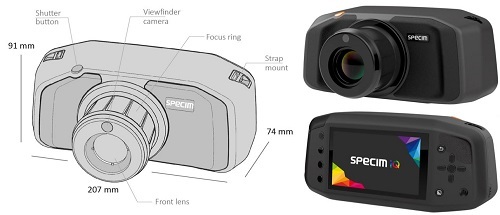
Figure 1 Intelligent Hyperspectral Camera SPECIM IQ (207mm*91mm*74mm)
After comparison, the results shown in Figure 2 are obtained. For the same sample, the spectral shapes acquired by the two devices are highly coincident: the average for the laboratory is 0.009 and the outdoor average is 0.043. The average standard deviations of SPECIM IQ and SPECIM V10E are indoor (0.017 and 0.021) and outdoor (0.029 and 0.029), respectively, but SPECIM IQ is more uniform, and SPECIM V10E has higher noise levels at the spectral boundaries (400-450 nm and 400-450 nm) 900-1000 nm, see Figure 2). Studies have shown that in addition to the atmospheric water vapor absorption band in the 925-970 nm range, the original signal of the surrounding spectrum is weak, resulting in a rapid increase in the reflected signal.
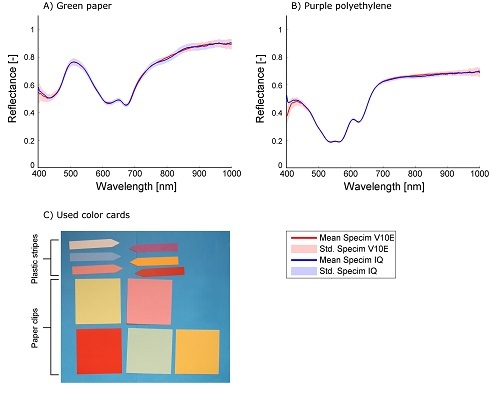
Figure 2 The average spectrum contains the standard deviation of green paper (A) and purple polyethylene (B), and C represents the sample of different colors for indoor testing.
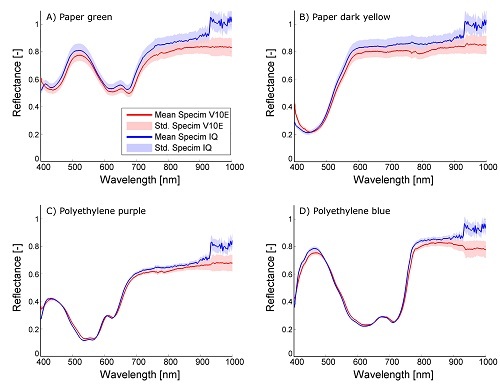
Figure 3 Spectral contrast of outdoor data (AD): green paper, dark yellow paper, purple polyethylene film, and blue polyethylene film
2. Physiological stress on Arabidopsis thaliana by handheld intelligent hyperspectral camera SPECIM IQ
Vegetation index can be used to evaluate the physiological structure and functional characteristics of vegetation under different conditions, including biomass, canopy structure, leaf area index, chlorophyll content and light utilization efficiency of plant canopy. The researchers used SPECIM IQ to study the physiological status of two variants of Arabidopsis thaliana under stress. Due to the lack of PsbS protein and violaxanthin deoxidase, the mutant samples of Arabidopsis have reduced light energy utilization (non-photochemical quenching), but can develop normally at room temperature, under high light conditions, mutants It may be damaged by light, which is invisible to the naked eye. The SPECIM IQ was used to collect data from 18 samples, and the collected data were subjected to vegetation index calculation. Based on this, the sensitivity of the sample to chlorophyll content and carotenoid conversion was evaluated (Fig. 4).
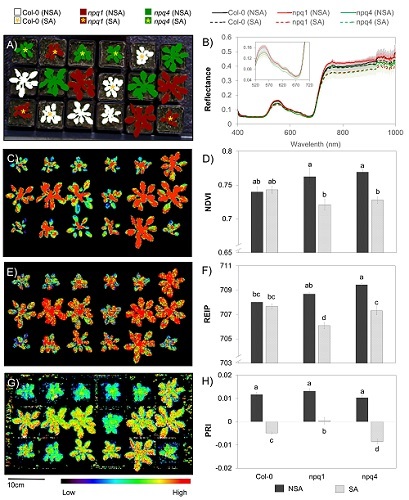
Figure 4. Differences observed between non-stress adaptation (NSA) and stress adaptation (SA) Arabidopsis wild type (Col-0) and PQ deficient mutants (npq1 and npq4). The left panel displays the false color image (A) of the selected region of interest; NDVI(C); REIP(E); and PRI(G) calculated from the data collected by SPECIM IQ. The right panel shows the calculated mean and standard deviation (B); NDVI(D); REIP(F); and PRI(H) are randomly distributed from the three separate plants in the imaging frame, with different letters indicating LSD-based Significant difference (a = 0.05).
Studies have shown that SPECIM IQ can be used to detect the content of chlorophyll (NDVI) and lutein (PRI) in Arabidopsis, and to accurately assess the status of plant samples. By verifying the representative vegetation index, it can provide examples for the evaluation of other vegetation indices and lay a foundation for obtaining more physiological information in the field of vegetation research.
3. Research on Barley Powdery Mildew by Handheld Intelligent Hyperspectral Camera SPECIM IQ
Hyperspectral imaging, as a non-contact measurement sensor, has great applications in assessing the severity of plant diseases and the susceptibility of host plants to specific plant pathogens. In this study, SPECIM IQ was used to assess the severity of powdery mildew on different canopy scales, and four and seven different levels of susceptibility to powdery mildew were compared between Milford and Tocada. The study accurately detected the symptoms of powdery mildew in two varieties and assessed the severity of different diseases by hyperspectral imaging combined with data analysis.
The researchers used SPECIM IQ to test 360 barley plant samples (cultured under stable diffuse light conditions) grown in the greenhouse, using a white reference plate (see Figure 5) and SPECIM IQ's built-in functions for hyperspectral data. Normalized. The researchers used SPECIM IQ Studio's spectral angle matching method (SAM) for infection detection and compared it with the support vector machine classification (SVM) method to detect areas with similar conditions in the upper leaves.
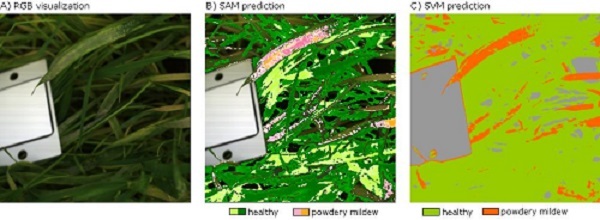
Figure 5 Classification of powdery mildew using spectral angle matching (SAM) and support vector machine (SVM) with a white reference panel on the left side of the image
Studies have shown that the symptoms of barley powdery mildew detected 25.8% and 4.4% of all plant pixels, while the healthy part was only 2.0% and 2.2%. The existing misclassification is mainly the effect of mixing pixels at the white reference boundary (which looks like a white mycelium on the leaf surface). In order to eliminate this systematic bias, the severity of the disease was determined by subtracting the amount of misclassified pixels, and a strong difference of 2.2% to 23.7% of the analyzed varieties was predicted. Therefore, SPECIM IQ can be used to measure the severity of disease in complex canopies and to control light source illumination conditions to ensure high signal quality. This study also demonstrates that SPECIM IQ spatial resolution is sufficient to determine a single symptom on barley leaves.
4, summary
The handheld intelligent SPECIM IQ camera has great potential for plant physiology and disease detection. Through the SPECIM IQ and SPECIM V10E indoor and outdoor environments, the measurement of different material color card radiation is evaluated, and the spectral characteristics of the two are highly consistent. The results from the vegetation index analysis indicate the potential of handheld intelligent SPECIM IQ in the context of plant research and phenotyping strategies: for the assessment of powdery mildew, SPECIM IQ has sufficient measurement capabilities and is combined with SVM. A high degree of consistency in visual assessment in quantification.
As the latest intelligent hyperspectral camera device, in addition to high-precision data quality, the handheld SPECIM IQ has high compactness, high mobility and fast integrated processing capability, which has created a favorable application for new fields of technology. condition. The release of the handheld intelligent SPECIM IQ allows hyperspectral sensor technology to be transmitted to the greenhouse and on-site at the quality level of laboratory equipment without the need for any carrier platforms or control and storage devices. Therefore, the birth of this device can undoubtedly support the various scenarios. Different applications and promote the development and impact of modern hyperspectral technology in more fields.
Head Massager,Bluetooth Eye Massager,Electric Head Massager,Relief Head Massager
Shenzhen Hongyutai Technology Co., Ltd. , https://www.redyut.com
